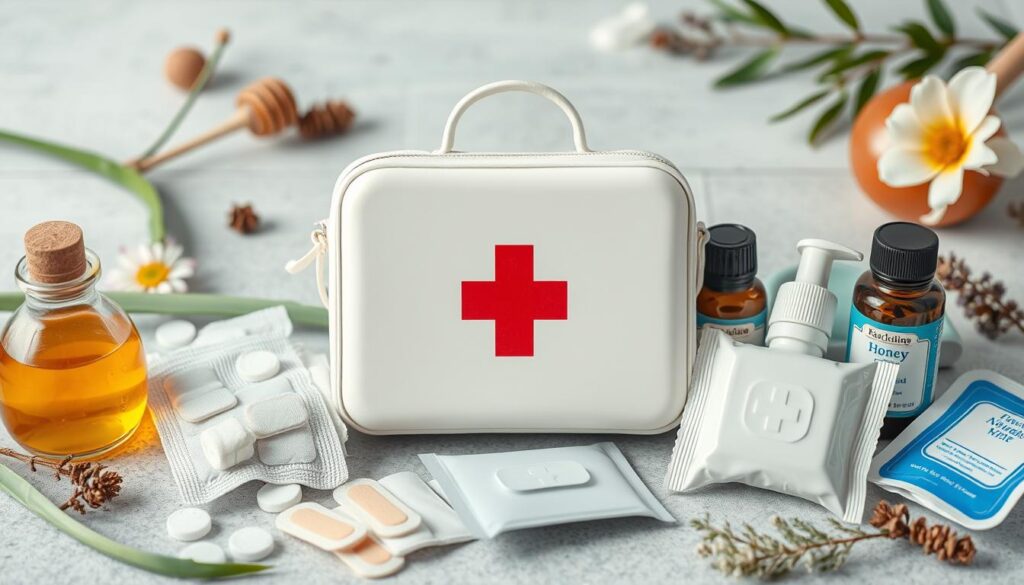Life has a way of throwing little surprises our way, doesn’t it? One moment you’re enjoying a sunny afternoon, and the next, a minor cut or scrape reminds you that accidents happen even in the safest of spaces. These minor injuries—whether it’s a scraped knee from an adventurous outing with kids or a burn from a hasty kitchen mishap—can disrupt our daily lives. However, knowing how to treat and prevent these injuries not only brings peace of mind but can also lead to quick recovery and avoid complications.
That’s where effective first aid and injury prevention come into play. Understanding how to address minor injuries and having the right tools at your fingertips can transform those painful moments into mere blips on life’s radar. Whether you’re a dedicated parent or someone who loves an active lifestyle, this guide will provide you with essential tips to treat and prevent minor injuries safely, helping you navigate life’s little bumps with confidence.
So, let’s delve into the strategies that can empower you to manage minor injuries effectively and keep your household safe!
Key Takeaways
- Understanding common types of minor injuries allows for quicker treatment.
- A well-stocked First Aid kit is essential for home and travel safety.
- Applying ice to an injury can help reduce swelling and pain.
- Immediate care is crucial for more serious injuries, such as head traumas.
- Injury prevention strategies can enhance your overall safety during activities.
- Home remedies can provide natural pain relief and promote healing.
Understanding Minor Injuries and Their Common Types
Minor injuries are a frequent part of everyday life, affecting people of all ages. They encompass a variety of conditions, including minor cuts and bruises, sprains and strains, each presenting unique signs and symptoms. Millions of individuals experience these common injuries each year, making it essential to understand their characteristics and how to manage them effectively. Recognizing when to apply basic first aid can aid in faster recovery and determine when to seek medical attention.
Common Minor Injuries
Among the most prevalent types of minor injuries are minor cuts and bruises, which often stop bleeding after a few minutes. While generally not serious, these injuries still require proper care to avoid infection and promote healing. For sprains and strains, individuals might notice swelling immediately, with severe cases potentially causing partial or full tearing of ligaments. Interestingly, children are more prone to breaking bones than experiencing sprains. Signs indicating a sprain in young children can easily resemble those of a fracture, necessitating careful evaluation.
Basic care guidelines support the management of sprains and strains, recommending the RICE method: Rest, Ice, Compress, and Elevate. Over-the-counter medications like acetaminophen and ibuprofen can help alleviate pain, but caution is required with dosages for younger children. Protective gear, proper conditioning, and stretching can significantly reduce the risk of these common injuries, underscoring the importance of preparation before engaging in physical activities.
Essential First Aid Kits for Home and Travel
A well-stocked first aid kit is vital for addressing minor injuries and ensuring injury prevention. Most individuals will need to use a first aid kit at some point, making preparation key. It is advisable to have both home and travel kits tailored to specific needs.
What to Include in Your First Aid Kit
Whether at home or on the road, having essential supplies can make a significant difference in managing injuries. A home first aid kit should include items like bandages of assorted sizes, antiseptic wipes, antibiotic ointment, scissors, gloves, and antihistamines. For travelers, a more comprehensive kit is essential due to the potential inaccessibility of a drug store. This kit might consist of adhesive tape, antidiarrheals, blister care products like moleskin, insect repellent, and even a book on first aid. Consider including medications for regular use, pain relievers such as ibuprofen or acetaminophen, and emergency contact information in your first aid kit.
How to Store Your First Aid Kit
Storing your first aid kit correctly is equally important. The kitchen is often deemed the best location for household kits, ensuring they are accessible during emergencies yet positioned out of children’s reach. Conduct routine checks every six months to replace expired supplies and ensure your first aid kit is ready for unforeseen events. Keeping a flashlight with functional batteries in the kit is also crucial for emergencies. When traveling, be mindful of volume limits in carry-on bags and remember to check expiration dates of all medicines.

Effective Tips to Treat and Prevent Minor Injuries Safely
Understanding how to properly address minor injuries plays a crucial role in effective wound care. Taking appropriate safety measures can significantly reduce discomfort and complications. This section covers essential steps for treating minor cuts, scrapes, burns, and bruises, along with guidance on when to seek professional medical help.
Steps for Minor Cuts and Scrapes
For minor cuts and scrapes, first, clean the wound using soap and water to remove dirt and bacteria. Apply a topical antibiotic ointment to prevent infection. Afterward, cover the area with a sterile bandage to promote healing. Monitor the wound for signs of infection, including increased redness or pus. Prompt attention to wound care is vital when treating minor injuries to ensure swift recovery and avoid complications.
Managing Minor Burns and Bruises
In the case of minor burns, cool the affected area by running it under cool water for several minutes. Cover the burn with a clean, dry cloth to protect it from infection. Bruises can be managed effectively with rest, ice, compression, and elevation, often referred to as the RICE method. Apply an ice pack for 20 minutes every hour to relieve pain and reduce swelling. This proactive approach aids in effective wound care and enhances recovery.
Recognizing When to Seek Medical Help
Being vigilant about recognizing when injuries may require professional care is crucial. If bleeding from a cut does not stop after applying pressure for 10 minutes, consulting a healthcare provider is necessary. Seek immediate medical help for burns that cover a large area, or if symptoms worsen. Understanding the proper safety measures can help prevent minor injuries from escalating into more serious conditions.
Injury Prevention Strategies for an Active Lifestyle
Engaging in an active lifestyle can lead to various minor injuries such as muscle strains, sprains, and cuts. Implementing effective injury prevention strategies is essential for staying safe during physical activities. This section explores key methods that help minimize injury risks.
Warming Up and Cooling Down Properly
Starting with a proper warm-up is vital for reducing the risk of injuries. Engaging in light cardio for 5 to 10 minutes prepares the body for more intense activity. Incorporating stretching and mobility exercises improves flexibility and decreases the likelihood of injuries. After workouts, it is equally important to cool down. Spending another 5 to 10 minutes on low-intensity activities helps the body recover and reduces muscle stiffness.
Maintaining Proper Technique and Equipment
Using the right equipment plays a significant role in injury prevention. Investing in high-quality shoes that provide support and traction helps protect against slips and falls. Additionally, utilizing safety gear like helmets, knee pads, and wrist guards can significantly reduce injury potential during various sports. Proper technique during exercise, including maintaining correct posture and alignment, minimizes the risk of strains and other injuries. Seeking guidance from qualified instructors can further enhance safety measures.
Listening to Your Body
Awareness of your body’s signals is crucial for maintaining an active lifestyle without injuries. Paying attention to discomfort or pain during exercise lets you address issues before they escalate. Resting and allowing time for recovery is key when dealing with minor injuries such as strains. If pain persists, seeking professional help is necessary. Remember, pushing through pain can lead to more severe injuries, so prioritizing your well-being is essential.

Safe Home Remedies for Pain Relief and Recovery
Exploring natural treatments can provide effective solutions for pain relief and recovery from minor injuries. Various home remedies offer a comforting touch while aiding in a faster healing process. Understanding these remedies and techniques empowers individuals to take care of minor injuries at home before needing professional assistance.
Using Aloe Vera and Other Natural Treatments
Aloe vera stands out among home remedies for its soothing properties, particularly beneficial for treating minor burns. This versatile plant not only helps alleviate pain but also hydrates the skin. Natural ingredients such as turmeric, ginger, and lavender have demonstrated pain-relieving capabilities. Turmeric, enriched with curcumin, aids in reducing inflammation, making it a fantastic choice for conditions like arthritis. Ginger has been shown to be as effective as ibuprofen for managing pain. The presence of phenolic compounds in herbs like rosemary and feverfew further enhances their antioxidant and anti-inflammatory properties, making them strong allies in pain relief.
The RICE Method for Minor Injuries
The RICE method, which stands for Rest, Ice, Compression, and Elevation, proves essential in managing sprains and strains. Resting the affected area prevents further injury, while applying ice reduces swelling and inflammation. Compression helps stabilize the injury, adding support during recovery. Elevating the injured area assists in minimizing swelling, promoting faster healing. This effective method is particularly useful for acute injuries, providing a framework to alleviate pain and support recovery naturally.
Conclusion
In summary, understanding minor injuries and having the right treatment and prevention strategies can significantly enhance safety at home and during physical activities. This article has provided effective tips on how to treat and prevent minor injuries safely. It is essential to maintain a well-stocked first aid kit and be familiar with practical treatments to address common injuries, which can be invaluable in emergency situations.
Additionally, emphasizing injury prevention strategies allows individuals to engage actively in their daily lives while minimizing the risks associated with physical activities. With statistics indicating that a substantial percentage of older adults experience falls each year, it becomes even more critical to implement preventative measures and be cautious about surroundings.
By incorporating these strategies into your routine, you can enjoy a healthier lifestyle, armed with the knowledge and skills to manage minor injuries effectively. Prioritizing safety and preparedness not only enhances your own well-being but also contributes to a more secure environment for those around you.











